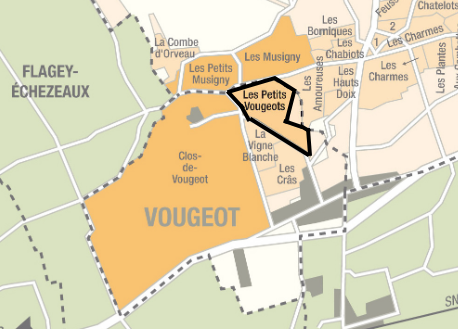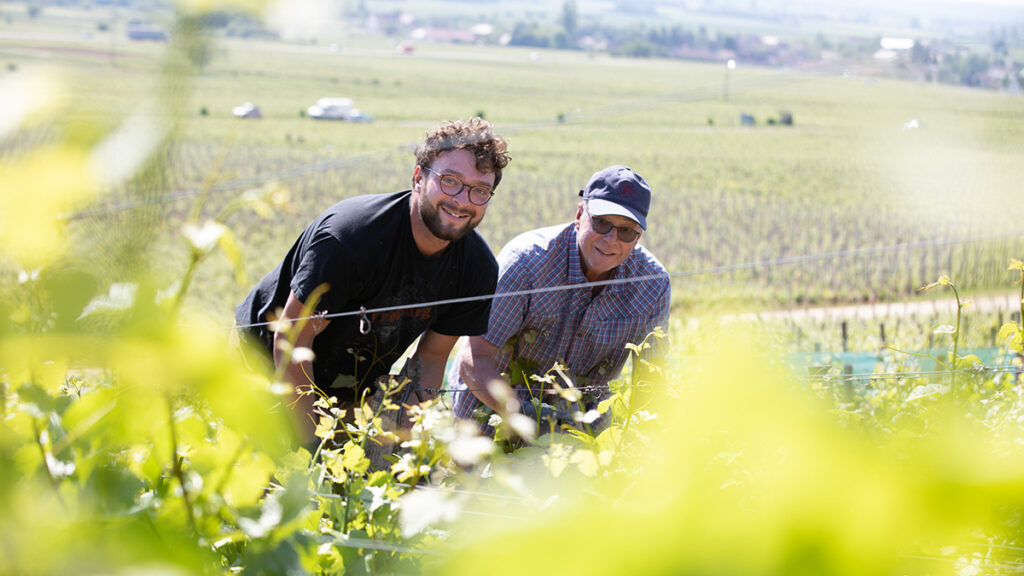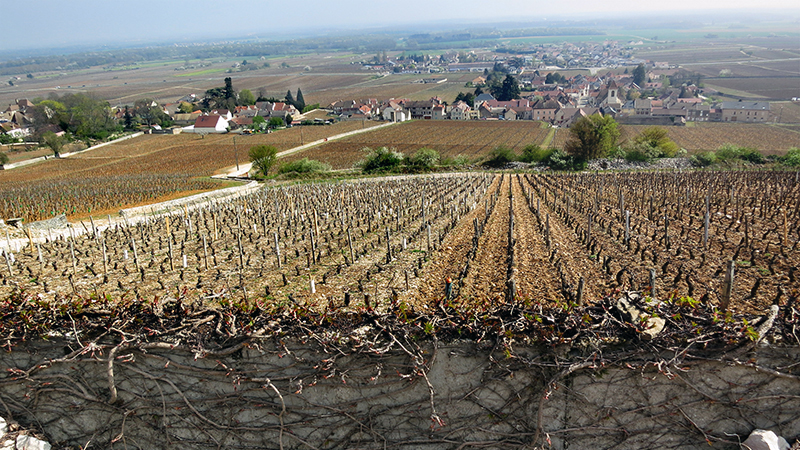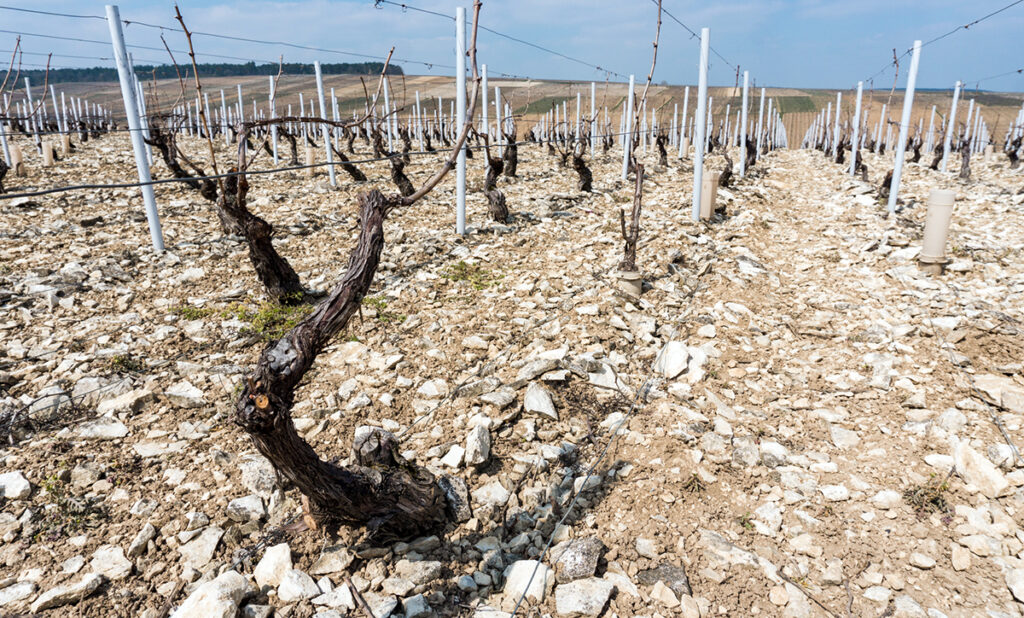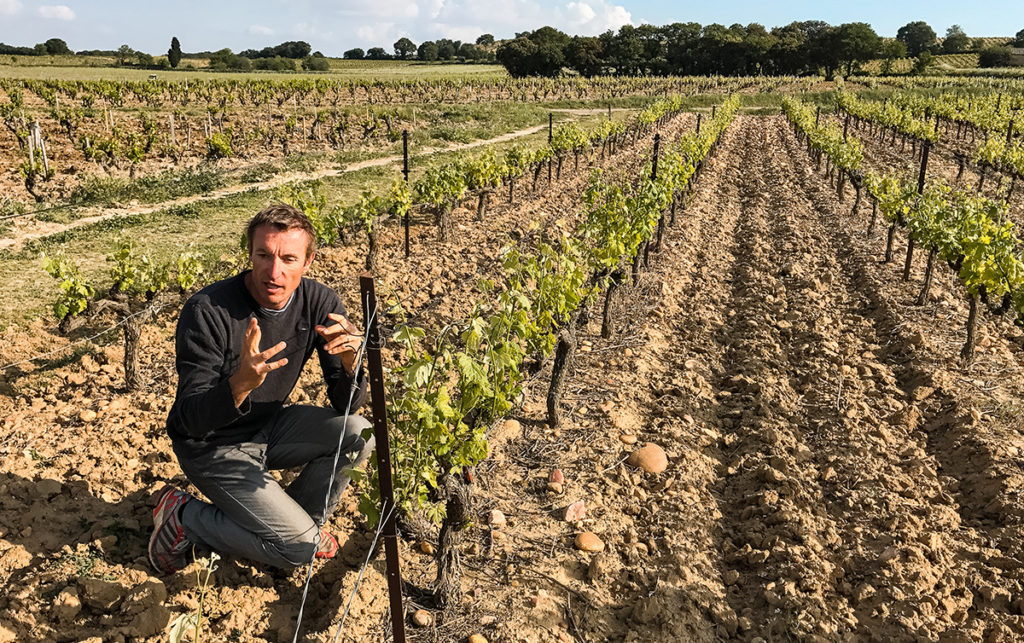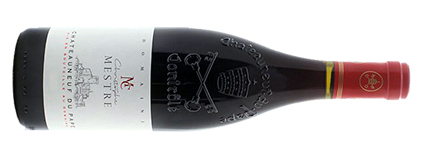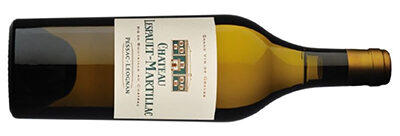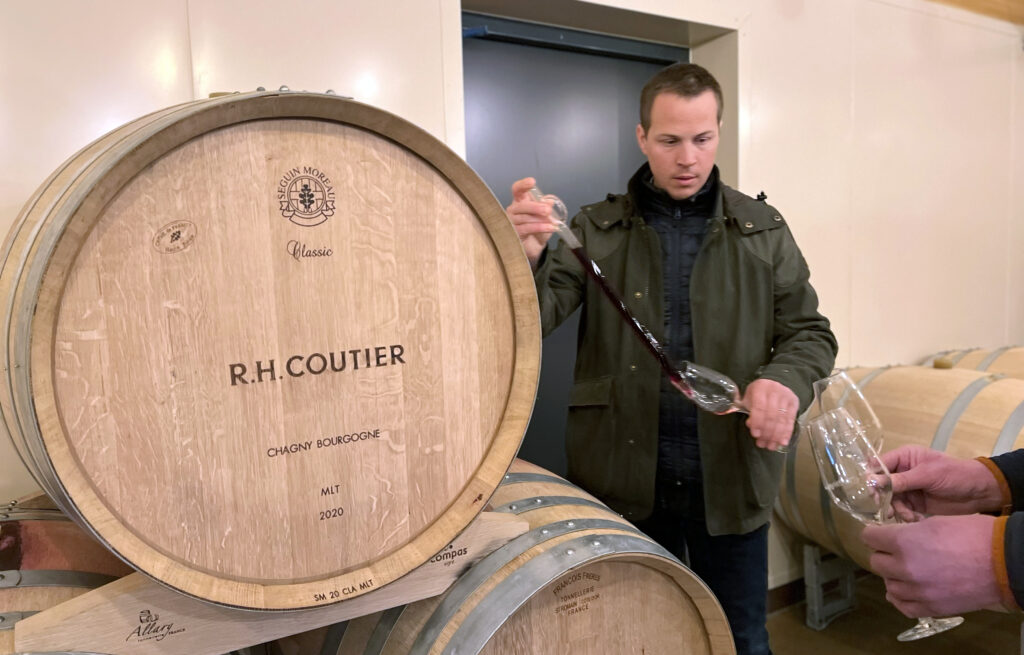We began this year’s Spring tasting trip in Bordeaux, our first visit to the region in years. There we found some attractive wines to share with you in the coming months (including one in this offering); but the visit was also a reminder of the difference in scale between Bordeaux and Burgundy. Bordeaux is ten times the size of Burgundy. Large enterprises dominate the landscape, with both staffing and production levels that are multiples of those in Burgundy. And the marketplace is dominated by the Place de Bordeaux, a long established marketing system with its roots in the 1855 classification of the vineyards. It is possible to find family producers where two or three generations work together on all the elements of grape growing, winemaking and sales, but they are few and far between. We love good Bordeaux, and we will continue to seek out exciting wines for you there from all sorts of producers there; but we also confess to a feeling like returning home as we entered the walled city of Beaune, where we always see friends and often encounter vignerons we know on the street. This Futures offering continues to highlight the excellent 2022 vintage in Burgundy. We’re also excited to introduce three new producers to the Ansonia portoflio, from Burgundy, Bordeaux, and Champagne. In Burgundy there are reds from two first rate producers in the Côte de Nuits and excellent whites from two others, one in the Côte de Beaune and another in Chablis. We also feature some Loire Valley white as well as reds from both the Southern and Northern Rhône. Finally, have an exciting new producer of grower Champagne to suggest. Our goal is always to propose wines for every taste and budget, and we hope you’ll find something of interest. If you do, please be sure to submit your orders, in case or half-case lots, by the Order Deadline of Sunday, May 19, 2024. We will place orders for the wine immediately thereafter. JUMP TO PRODUCER
Clerget
Amiot
Morey
Collet
Mestre/Joncuas
Tunnel
Fontainerie
Lespault-Martillac
Coutier
May Futures
Order Deadline: 5/19
Domaine Christian Clerget
Vougeot, Burgundy
Longtime readers may recognize the Domaine Christian Clerget – we imported their wines until 2013, when they signed up with a national US importer who required exclusivity. We’ve checked in by email every few years as we’ve enjoyed the last few Clerget bottles in our cellar – and after some luck and a bit of patience, we’re delighted to welcome them back into the Ansonia portfolio. The winemaking team has changed a bit in our decade away. Christian’s daughter Justine returned to the domaine in 2015, taking the lead as winemaker in 2017. But in practice this has always been (and continues to be) a family affair – Isabelle (mère) runs the front office, and during our barrel tasting wine Justine last month it was Christian (père) in the next room over, waving to us from behind the bottling machine. As is often the case with her generation, Justine has returned to her family domaine with renewed energy, refined techniques, and a passion for organic viticulture. The Clerget wines were always classical, terroir-transparent, old school red Burgundy; Justine has maintained this spirit but added polish and class. We’re thrilled to have these brilliant wines back in our lineup, and we suspect you’ll enjoy them too. Even by Burgundian standards this is a tiny operation – the Clergets farm 6 hectares (14 acres) of average 60 year old vines across 8 appellations in and around the tiny town of Vougeot (population 174). Our allocation is proportionally sized, so if any of these wines call to you, we counsel placing your order without delay. First Clerget’s Bourgogne Rouge 2022 – grown from 40+ year old vines in the communes of Vougeot and Vosne, this is punchy, delicious red Burgundy with the signature Clerget elegance. There’s remarkable intensity of fruit – particularly for a wine of its level – with notes of raspberry jam and a touch of earth. Burghound named it a “top value” Bourgogne, calling it “delicious” and “velvet-textured.” Jasper Morris writes: “the fruit is attractive and quite succulent… all in balance.” This is everything you want in a Bourgogne rouge, and nothing you don’t. At the village level, the Clergets have two wines, one in Chambolle (just north of Vougeot) and one in Vosne (just south). The Chambolle is a blend from six different plots around the town, and shows the village’s classic silky, seductive nature. Neal Martin gave 90-92 points, praising its “sense of vibrancy and tension” on a “very well-controlled and persistent finish,” concluding “this is worth seeking out.” This is a wine of perfume, elegance, and grace, but with real density from the hot, dry summer – we think it punches above its village weight. The Clerget’s Vosne-Romanée parcel is a special one (pictured above). Immediately south of the southern wall of the Grand Cru Clos Vougeot lies “Les Violettes,” where Justine farms a tiny (less than an acre) plot of vines planted in 1945, just after the war. Nearing their ninth decade, these veteran vines produce exceptional juice – deep, concentrated, and intensely Vosne-Romanée. The texture is inky velvet – Neal Martin found “fine-boned tannins and a tensile, mineral-driven finish.” But as the wine’s name will suggest, it’s the nose that’s the most memorable here – the wine explodes with classical Vosne violets, alongside roses and chalk. Pour this into your biggest glass, sit back, and watch it expand. At the premier cru level the Clerget’s have an enviable selection of vines in Chambolle and Vougeot. Their Chambolle 1er cru “Les Charmes” is as appropriately named as the Vosne Violettes – a charming, classically Chambolle wine with a terrific dose of depth and intensity. Neal Martin gave 92-94 points, calling it “very well-crafted” with “fine tannins” and “silky-smooth texture.” Not to be outdone, Jasper Morris gave 92-95, finding “a joyous, almost rumbustious energy,” and “excellent length.” This was probably the hardest of any of the wines to spit out during our tasting, but should age beautifully. About 80% of the vines in the town of Vougeot are part of the enormous Clos Vougeot Grand Cru, but the other 20% covers some exceptional premier crus, including “Petits Vougeots,” which borders both Clos Vougeot and Le Musigny over the border. The Clerget’s plot here produces impressive wines, bolder than the Chambolles and approaching the concentration of the nearby Grand Cru. Broad, sturdy and delicious, this is not a wine you’ll soon forget. Burghound found “lovely mid-palate texture” and awarded 91-93; Neal Martin found it “very well balanced,” concluding “a solid, well-crafted Vougeot.” This will need at least a few years before opening, and will reward 10-15 with ease. Finally, Echezeaux (one of two we’re adding this year – when it rains…), the legendary Grand Cru. Clerget’s vines here were planted in 1947, and the resulting wine is every bit a Grand Cru, worthy of reverence and some patience. Particularly in 2022 this is big, powerful wine, with smooth inky fruit resting on broad shoulders. Jasper Morris (93-95 points) called it “a charming and graceful Echezeaux;” Neal Martin suggested a drinking window of 2028-2045, finding it “beautifully defined, with lifted brambly red fruit, sous bois, and incense.” We enjoyed a 2006 of this cuvée a few years ago at age 15 that was exquisite. (It’s hard to call a $166 bottle a deal with a straight face, but particularly at the premier cru and grand cru levels Clerget’s wines are priced well below their peers.) If you’ve got the budget and the cellar space, this is a special wine.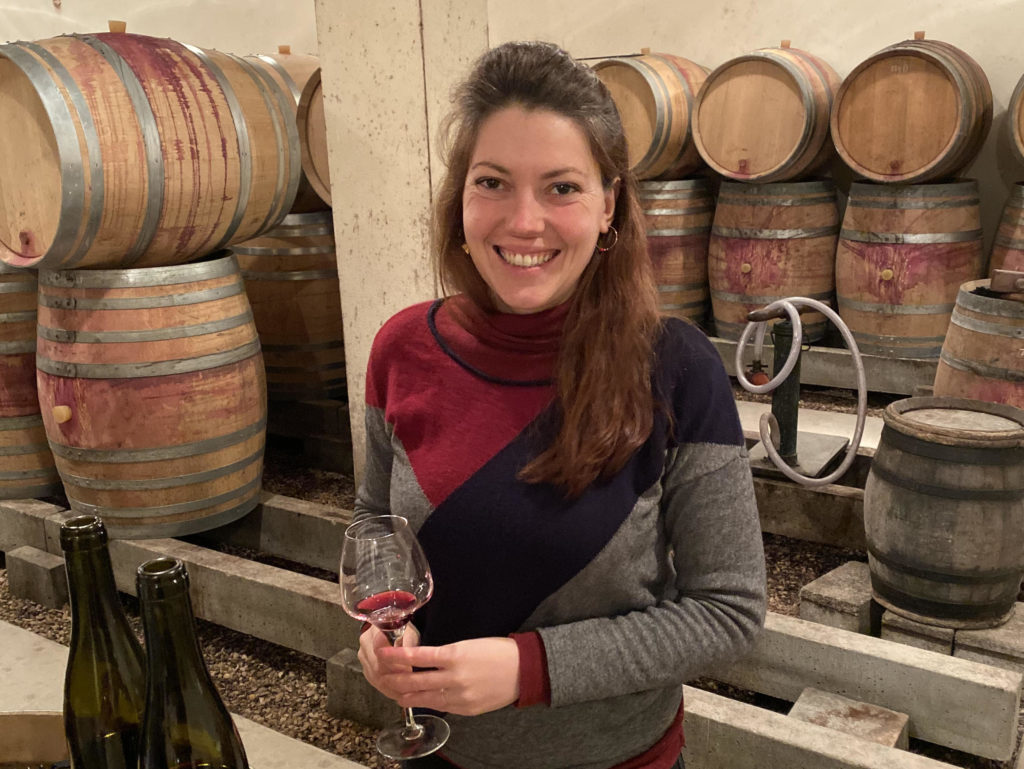
CLERGET Bourgogne rouge 2022: $425 *Chambolle-Musigny 1er “Charmes” 2022: $1195 *Echezeaux Grand Cru 2022: $2095
(case prices)
Chambolle-Musigny 2022: $795
*Vosne-Romanée “Violettes” 2022: $995
*Vougeot 1er “Petits Vougeots” 2022: $1195
*(wines marked with asterisks are available by the quarter case)
Domaine Amiot et fils
Morey-St-Denis, Burgundy
The town of Morey St. Denis doesn’t get as much publicity as the famous neighbors on either side (Gevrey-Chambertin to the north and Chambolle-Musigny to the south), but it is home to some of the Côte d’Or’s very best terroir. There are five Grand Cru vineyards within its borders, not to mention a long list of superb premier crus. The Domaine Amiot, led by Jean-Louis Amiot, has offered wonderful red Burgundy for a generation. Jean-Louis’s son Léon joined in the management of the family properties in recent years, and the result is a serendipitous blend of experience and youthful energy. The wines are as good as ever, and the domaine is proceeding as thoughtfully as anyone in dealing with a warming climate. At the regional level, the Amiots now offer two wines. The newer cuvée, Coteaux Bourguignon, is a blend of equal parts Gamay and Pinot Noir. The Gamay adds a pleasant rustic note to the nicely ripe Pinot fruit, and the result is a tasty, straightforward wine that will be a great accompaniment for a picnic on a warm summer day, or for hot dogs and hamburgers on the grill. The Bourgogne Côte d’Or 2022 is more serious. Its ripe nose of pure Pinot Noir resides in a deeper, more structured palate that nonetheless should drink well from the time it arrives. Clean and pure, with intense fruit and low toast, it’s an excellent introduction to the Amiot style. The domaine makes a small quantity of village Gevrey-Chambertin and Chambolle-Musigny from purchased grapes. The Gevrey-Chambertin 2022 has an attractive register of floral high notes. In the mouth there is dark fruit with very good density, and the flavors persist nicely on the palate. It’s a classic Gevrey – bold and delicious with friendly tannins and lots of character. It’s also one of the best values in the Amiots’ lineup. Their 2022 Chambolle-Musigny is very Chambolle, with a pretty rather than powerful profile, and just the right touch of oak in the nose. The mid-palate has lovely ripe cherry fruit and fine-grained tannins. We’ll probably pull the first cork on these in late fall or early winter, but there’s no need to rush to drink either of these wines. The Amiots have three fine premier cru reds from Morey St. Denis, and 2022 produced excellent examples of all three. The Morey St. Denis 1er cru “Aux Charmes” is well-named. It is usually the first of the three to drink well, and that is likely to be the case with this vintage. Already aromatically expressive, it garnered praise from Allen Meadows (Burghound) for its “layered mix of red and dark pinot fruit, anise and soft floral wisps” as well as its “delicious, rich and quite suave medium-bodied flavors.” This ages beautifully, but it’s hard to keep your hands off it young – the 2021, from a less accessible vintage, is already delicious. The Morey St. Denis 1er cru “Les Millandes” is a bigger wine, with more structure and the need for a little more time to integrate its elements. There’s a bit more oak (30% new barrels vs. 20% in Charmes) and a similar increase in whole clusters. As Burghound put it, “The sleek, delicious, and tension-filled larger-bodied and tautly muscular flavors display the hallmark power of a classic Millandes.” This is very refined, and very Morey-St-Denis. Finally, there is the superb Morey St. Denis premier cru “Les Ruchots,” just down the slope from the Grand Cru Clos de Tart, and just up from the Domaine Roumier’s monopole Clos de la Bussière. From what most consider the best premier cru terroir in the village, this wine combines intensity and elegance, with exceedingly fine-grained tannins that produce what Burghound calls “a caressing, even sappy, mouthfeel.” It’s always a favorite of ours, with a long life of great complexity and exceptional length on the palate. There’s just a single premier cru from Gevrey-Chambertin – “Les Combottes” – but it’s a special one. If such distinctions were possible, Combottes would likely be ranked between premier cru and grand cru, perhaps closer to Grand Cru. It is a vineyard completely surrounded by Grand Crus, and it develops Grand Cru-like complexity and nuance as it ages. Burghound identified an “elegant and floral nose” with “aromas of red and black raspberry, violet and a similar hint of exotic tea.” He wrote this about the 2022, giving 90-93 points: “The innate elegance of a fine Combottes is immediately evident with the refined and lacy flavors that exude a subtle minerality on the dusty, linear, youthfully austere and beautifully detailed finale.” At $116 It’s unlikely to become your next house red, but it comes in at a fraction of other its neighbors (Lignier, $300; Dujac, $350; Trapet, $350). Those with budget and patience will be handsomely rewarded. Finally, the Grand Cru Clos de la Roche 2022 is built for a very long life. It has dense, dark cherry fruit mixed with a solid dose of oak. There is plenty of power here, and the length is exceptional. But patience will be required to enjoy it near its peak; Burghound (91-94pts) says “this is definitely a wine to buy and cellar as it’s not likely to be especially approachable young,” finding “power and muscle” with an “impressively long, austere, built-to-age and quite serious finale.” That won’t prevent us from putting it in a carafe after a few years, but you will definitely need one if you want it to open up for drinking inside eight or ten years. 
AMIOT Coteaux-Bourguignons 2022: $295 Gevrey-Chambertin 2022: $795 *Morey-St-Denis 1er “Charmes” 2022: $995 **Clos de la Roche Grand Cru 2022: $3,540
(case prices)
Bourgogne rouge 2022: $395
Chambolle-Musigny 2022: $995
*Morey-St-Denis 1er “Millandes” 2022: $995
*Morey-St-Denis 1er “Ruchots” 2022: $1,195
*Gevrey-Chambertin 1er “Combottes” 2022: $1,395
*(wines marked with one asterisk are available by the quarter case)
**(wines marked with two asterisks are available by the bottle)
Domaine Thomas Morey
Chassagne-Montrachet, Burgundy
Look up “Thomas Morey” in the proverbial Ansonia winemaker dictionary, and you’ll find words like “deliberate,” “thoughtful,” “minimalist,” “precise.” You won’t find “opulent,” “generous” or “showy.” Morey’s cellar style is as clean and detailed as his wire rimmed glasses and his Zalto stemware. He’ll only agree to tasting appointments in the morning, and our visits are full of long contemplative silences. Morey’s wines somehow continue to get better. You might imagine a hot dry year like 2022 would threaten to blur his crisp, focused style, but Morey has turned in a classic vintage, and each cuvée perfectly reflects its terroir. As usual, the only thing wrong with these wines is their scarcity – for the last two years nearly the entire allocation has been snapped up in Futures, and we expect similar things in this terrific vintage. Thomas included the Bourgogne blanc in our allocation for the first time this year. It’s just what you’d expect – clean fruit, a fresh mouthfeel and perfectly balanced acidity. With 10% new oak, this is pretty and precise. It’s not as complex as the Chassagnes, of course, but at $35 it doesn’t need to be. Drink this to hold yourself back from opening his village and premier crus too early. The Chassagne village is a blend of seven plots, including a few declassified premier crus. The 2022 is golden and beautiful, showing remarkable length for its level. Jasper Morris gave 90-93 points, writing, “I can be unconvinced by a village white Chassagne-Montrachet, but here Thomas Morey has produced an absolutely delightful example.” Look for white flowers, pear, and lime. Morey has an impressive array of premier cru plots around the appellation. At the southern end of Chassagne there are two – Embrazées and Morgeot. The vines in Chassagne 1er cru Embrazées are 63 years old, planted by Thomas’s grandfather in a field that had been abandoned after phylloxera. The 2022 is a stunner – long and lithe with deep fruit channeled beautifully into a concentrated core that ripples with energy and intensity. Morey’s usual restraint is in effect, and the wine is rich without an ounce of heaviness. Chassagne 1er cru Morgeot, further down the slope, has more sun and more clay, and produces bolder wine that’s no less charming. Morey’s cuvée is a blend of two plots in the Morgeot sector, and it’s exceptional in 2022. Jasper Morris awarded 94-96 points and 5/5 stars, calling it “spectacular.” He writes “the bouquet indicates a wealth of fruit to come, and so it does, in several waves across the palate. This has layers of fruit waiting to develop over many years to come.” We don’t think anyone will turn down a glass of this in the next year or so, but if you have the patience this should cellar beautifully. Switching towns for one wine, we find ourselves just north in Puligny-Montrachet where Thomas Morey has a small plot in “Truffiere,” a premier cru vineyard next to Champ-Gain and Folatières. This is always classical Puligny, and the 2022 is no exception – it almost resembles Chassagne in the nose this year, with lush pear, hazelnut and herbs, but in the mouth it could only be from Puligny. A chiseled stony texture underlies the dry white fruit, with real intensity, and a long, classy finish. Morey’s style fits perfectly with Puligny, and this wine is a triumph. Thomas Morey is one of only four owners of the tiny gem Chassagne Premier Cru Vide Bourse vineyard – this is special wine, from vines on the border with Puligny and directly abutting the Grand Cru Batard-Montrachet to the west. Jasper Morris calls Morey’s Vide Bourse a “baby Batard-Montrachet,” and one taste makes it easy to see why. This cuvée is extraordinarily rich and deep, with a gorgeous floral nose and layers upon layers of fruit in the mouth. It finishes (after taking its time) clean, dry and elegant – a rollercoaster of a wine that is, as Morris puts it, giving 92-95 points, “fine and sturdy at the same time.” And finally, the Batard-Montrachet itself. Grand Cru is often hard to taste at this early stage, but this year’s was holding nothing back. An exquisite nose of yellow fruits, wild honey and melon combines with lemon peel and chalk in the mouth to create a symphony of striking notes. Morris found “peaches and honeysuckle,” and a “central core of white fruit,” awarding 92-96. As usual this wine should age for a decade with ease, but we think this year’s may be more accessible early should thirst or space constraints force your hand. A magnificent wine, worthy of its top billing. The two red wines chez Morey may be an afterthought following such a brilliant lineup of whites, but readers who have had them know just how tasty they can be. The first, a Santenay 1er cru from “Grand Clos Rousseau” is terrific, a punchy Côte de Beaune red with unusual concentration and Morey’s signature polish. Look for dark blue fruits with earth and briary black raspberry. We think its a very good value and should drink well immediately. The second is a premier cru from Beaune “Grèves,” one of the town’s best sites. It’s stonier and finer than the Santenay, combining the precision and lift of the terroir with a ripe-fruited vintage. We found it unusually floral this year, with notes of cassis, roses, and cherry blossom. This ages beautifully and given 3-5 years should be an exceptional, focused red Burgundy.


THOMAS MOREY Bourgogne blanc 2022: $425 *Chassagne-Montrachet 1er “Embrazées” 2022: $950 **Batard-Montrachet Grand Cru 2022: $4740 Santenay 1er “Grand Clos Roussot” rouge 2022: $595 *(wines marked with one asterisk are available by the quarter case)
(case prices)
Chassagne-Montrachet 2022: $750
*Chassagne-Montrachet 1er “Morgeot” 2022: $995
*Puligny-Montrachet 1er “Truffiere” 2022: $1295
*Chassagne-Montrachet 1er “Vide Bourse” 2022: $1395
Beaune 1er “Grèves” 2022: $625
**(wines marked with two asterisks are available by the bottle)
Domaine Jean Collet
Chablis, Burgundy
The Domaine Jean Collet owns a remarkable assemblage of vineyards spread across every sector of Chablis. Many of them are huge by Burgundy standards: in Vaillons, the Domaine is the largest landholder, with more than 9 hectares (almost 23 acres); in Montmains they are among the top five holders, with almost five hectares. All of these vines are fertile ground for Romain Collet, their talented millennial winemaker with a penchant for experimentation, as he matches the Domaine’s various plots with techniques new and old. When we visit we see stainless steel and large foudres, of course, but also oak barrels of various sizes, from the traditional 300-bottle pieces of the Côte d’Or to larger demi-muids and other barrels designed to vary their contribution of oak flavor and micro-oxygenation. More recently there are also cement eggs and amphoras, which have their own unique influences on the wines raised in them. Our first suggestion in the 2022 vintage is Vallée de Valvan. If you don’t recognize the name, there’s a reason: 2022 is the first year that Valvan, at a spot just over the crest of the hill of Montmains, has the right to separate bottling. Lovers of Montmains, which is usually vinified in the classic Chablis style — steely pure fruit with freshness and energy — will enjoy this organic village cuvée. Jasper Morris MW was impressed. He found it “generous yet classic on the palate, with a weight of fruit threaded by adequate acidity,” concluding, “good stuff.” It is indeed attractively ripe without loss of focus, and its rank at the village level makes it a particular value. If you’re a fan of Montmains premier cru itself (on the other side of that crest), you will like the 2022 vintage. Its pure fruit is as described above, and we love its classic Chablis character. There is excellent concentration and length to go with the fruit, and we were struck by the wine’s dry and savory character – Morris found “excellent persistence.” Whether you’re going for a classic pairing of Chablis with oysters or looking to complement a filet of fish sauteed in butter, this Montmains can work all sorts of magic at the table. Vaillons premier cru has its own ridge running parallel to Montmains, and in style Collet’s Vaillons falls in the middle between the no-oak wines like Valvan and Montmains on the one hand and the Côte d’Or-style wines raised in oak on the other. It is raised one-third in vat, one-third in large wooden foudres (which round the wine through micro-oxygenation without adding oak flavor), and one-third in smaller oak barrels. Its place on this spectrum makes it a versatile wine, enjoyable young for its fruit, but developing aromatically as it ages. We’ll often turn to this wine when we’re trying a new dish or seeking a reliable partner for a familiar one. As we’ve said before, a warming climate creates scope for making wines in Chablis that resemble those of the Côte d’Or (except for pricing). “Butteaux,” featured in last week’s introductory post for this Futures offer, is such a wine. It begins with older vines – 35 years on average – and after vinification in stainless steel the wine finishes its élevage in the traditional oak barrels of the Côte d’Or. It is layered and beautiful, and we think that in a blind tasting many sophisticated lovers of white Burgundy would place it in Puligny or Chassagne. Morris agreed, rating 91-94pts, and writing “Lovely generous fruit yet with tension. Very good this year.” Many of you already know Forêts premier cru, another Collet Chablis that could fool you into thinking it came from the Côte d’Or. Like Butteaux, Forêts has substantial clay in its limestone soils. It’s a more densely planted vineyard, and while 10% of the wine is raised in Burgundian barrels, the rest has its elevage in cement eggs. What’s notable about the eggs is that their shape, combined with the natural influences of the lunar cycle, makes the lees move up into the wine and then descend, so the wine is effectively stirring itself. The resulting wine is exceptional for its richness and concentrated mouthfeel. Forêts 2022 also has excellent length, and should drink well from the time it arrives in the United States. Finally, the Domaine offers what is perhaps the best value available in a Grand Cru anywhere. Valmur Grand Cru 2022 offers superb balance between energy and richness. There is exceptional concentration, enough oak to play its part, and plenty of structural support to give the wine a long, delicious life. A bold wine with everything at once – fruit, wood, stones, and waxy thickness. Balancing Valmur is always a task, as the wine can become enormous with too much ripeness. Romain has succeeded beautifully in 2022 – Morris writes “Plenty of energy here without too overt an opulence.”

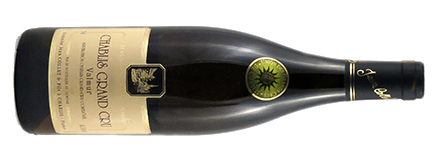
COLLET Chablis “Valvan” 2022: $325 Chablis 1er “Montmains” 2022: $395 Chablis Grand Cru “Valmur” 2022: $ 825
(case prices)
Chablis 1er “Vaillons” 2022: $395
Chablis 1er “Butteaux” 2022: $395
Chablis 1er “Forets” 2022: $395
Mestre & Joncuas
Southern Rhône Valley
Here we present a group of three Southern Rhône cousins together. They share a sunny climate and the beneficial influence of the Mistral, a cold wind that tumbles off the Massif Centrale and barrels through the Rhône valley at unpredictable intervals. The three towns lie along the same alluvial plain, just upstream from Avignon. The Domaine Mestre’s Chateauneuf-du-Pape comes from the appellation named for the Popes who lived there in the fourteenth century, and who promoted its wine over the centuries that followed. It is rich, round wine, a fine match for all sorts of meals when the weather cools and the fireplace is a welcome gathering place. Half the grapes are Mourvedre and 40% are Grenache, with Syrah and just a touch of Cinsault rounding out the mix. Elevage is for 18 months, with seventy percent raised in foudres and other oak vessels, and the rest in cement eggs and vats. The 2022 vintage is particularly attractive. It offers an expressive nose of youthful fruit with attractive floral notes. Though it is warm and supple, there is also a noticeable freshness that prevents heaviness and keeps it juicy. Some Châteauneuf requires cellaring to achieve its potential – the Mestres build theirs for early and frequent enjoyment. With a futures price just under $30, there is little to match it for value. Across the plain in the shadow of the Dentelles de Montmirail (the “lace” mountains) lies Gigondas and its neighbor Vacqueyras. Sisters Dany and Carole Chastan of the Clos du Joncuas produce delicious wine from both villages. As we reported last year, the Beard-award honored writer Jon Bonné has named them a benchmark producer of the region, “essential defenders of grenache’s good name.” Indeed, Grenache is the dominant grape in all of their wines, and the delicious wild strawberry aromas are a virtue common to all of them. Their just-released 2022 Vacqueyras is delicious, and a terrific value. Like the Gigondas it is nearly all Grenache (85%). That gives it the same dark wild strawberry fruit, and the small portion of Mourvedre adds complexity. It’s a crowd-pleasing everyday red that should offer much pleasure over the next three or more years whenever the weather cools. Some of you may already have Clos du Joncuas Gigondas 2019 in your cellars. We were able to review a group of recent vintages for this offer, and we found that the Gigondas 2019 has evolved impressively since we recommended it two years ago. Floral elements recalling violets now join the sweet strawberry fruit in the nose, and while the wine still shows some structure, it is mouth filling and smooth across the palate. It is round and ripe, yet still fresh. (For readers familiar with Jacqueline André’s Châteauneuf-du-Pape, this is a similar layered style,) Fermented with all whole clusters, it’s full of earthy southern French character – a delightful old-school Rhône red offering excellent value.
MESTRE & JONCUAS Mestre Châteauneuf-du-Pape 2022: $350
(case prices)
Joncuas Vacuqueyras 2022: $295
Joncuas Gigondas 2019: $425
Domaine du Tunnel
Cornas, Northern Rhône
The appellations of the Northern Rhône are only a few hours away from those of the Southern Rhône, but they march to the beat of a different drummer. While Syrah is generally a supporting actor in the South, it is the star of the North, where most reds are made from 100% Syrah. The greatest wines from any grape are made at the northern end of its range, and Syrah proves this rule above all others. The leaders of the Northern Rhône appellations for red wine are Côte Rôtie, Hermitage, and Cornas. Stylistically, Côte Rôtie and Hermitage are yin and yang: the former is elegant and complex, the latter dark and brooding. Cornas is somewhere between, perhaps closer to Hermitage in power and intensity. And it is tiny, with about 150 hectares in the entire appellation. The Domaine du Tunnel is a producer in great demand, and not just for its novel cellars, constructed in an old railway tunnel. We have just tasted samples of the 2022 Cornas and the 2022 St. Joseph and we recommend both with enthusiasm. The St. Joseph 2022 comes from 40 year-old vines. Its 13% alcohol is a welcome level in any part of France these days, and we thought the 2022 had a lovely weight on the palate. There is a pleasant nose of dark fruit supported by exceedingly fine-grained tannins, and there is also excellent length. Vinous’s reviewer reported that “Vivid red and black cherry, violets and leafy subtleties rise up from the glass.” It’s a fine St. Joseph that will age well. The Cornas 2022 is also delicious. This bigger wine has an attractive mouthfeel. The dark fruit, mingling with cloves and spice, emerges slowly in the glass. We think this wine will drink well immediately, and be really turning heads in a few years. Vinous found it “polished and forward” and praised the “glossy red fruits paired with spicy undertones of black pepper and licorice.” Like the St. Joseph, this wine should offer years of drinking pleasure.
TUNNEL St-Joseph 2022: $525
(case prices)
Cornas 2022: $695
Domaine de la Fontainerie
Vouvray, Loire Valley
Last year we introduced our first Vouvray source, Domaine de la Fontainerie. We loved the wine but severely underbought, and promptly sold out from the store. We plan to remedy that error this year, and invite you to join us. Located in Vouvray in the central Loire Valley, Fontainerie is a small 6-hectare estate producing delicious wines of pure Chenin Blanc. The winemaker is Catherine Dhoye-Deruet – she’s run the place since the 90s, and it’s been in her family since the early 1700s. We’re suggesting two whites from Fontainerie this year, both dry and delicious, and both startlingly well priced. First, the Vouvray Sec 2022. This is just what we want from Vouvray – pure, classic, refreshing Chenin blanc, raised in steel (no oak) and fermented fully dry. The nose is floral and fresh, with notes of apple blossom, ripe pear, saffron and chalk. The mouth is clean and crisp, with smooth fruit and a clean finish. Simple, delightful summertime Chenin blanc. Fontainerie’s other cuvée comes from “Les Brûlés,” a south-facing plot of chalk limestone soils. The extra sun and deeper soils add more depth to the wine, and the 2022 Vouvray “Coteau les Brûlés” is deep and floral. The nose is perfumed and lovely with notes of baked apple crisp; the mouth is dry but fuller and riper than the Sec. Again there’s no oak, but there’s more savory spice behind the lush fruit. Serve this with sushi, and don’t be afraid to add the wasabi and pickled ginger – this wine can handle some flavor competition.
FONTAINERIE Vouvray sec 2022: $195
(case prices)
Vouvray Coteau les Brûlés sec 2022: $235
Chateau Lespault-Martillac
Pessac-Leognan, Bordeaux
As some readers may have seen on Instagram / YouTube, we started this spring’s trip with a few days in Bordeaux. It was a fascinating, at times perplexing visit – in many ways the region bears very little resemblance to Burgundy, in scale, pricing, distribution, and feel. But we found much to like, and hope to introduce several of our discoveries over the next few months. Somewhat unexpectedly one of the most memorable wines from Bordeaux was an eight year old white – a Pessac-Leognan blanc from the Château Lespault-Martillac. We were drawn to Lespault-Martillac from a note in Master of Wine Jane Anson’s terrific book “Inside Bordeaux,” where she calls them a source for “exceptional quality and good value Pessac.” The Chateau is overseen by the team from Domaine de Chevalier, one of the region’s finest sources. As at Chevalier, the viticulture is fully organic, and both chateaux benefit from their relatively high (for Bordeaux) elevation. The soils are clay-limestone with gravel, and the vines tend to ripen slowly from their cooler vantage point on the hill. We were quite taken with both reds and whites from the Domaine de Chevalier collection, and while the Chevalier wines are well distributed (and healthily priced), the Lespault-Martillac wines were just what we had come to Bordeaux to find. The scale is hardly Burgundian – we crossed paths with easily 30 employees during our hour-long visit in a quiet season – but the attention to detail and thoughtfulness of the operation is clear. We’re excited to begin with the 2016 Blanc, and doubt very much this will be our last visit here. Lespault-Martillac’s 2016 blanc is a blend of 70% Sauvignon Blanc and 30% Semillon – it’s barrel fermented and then given a 10 month elevage. The nose is dry, floral, and expressive with notes of citrus, lavender, lime zest and candle wax. The mouth is simply beautiful – fully mature with terrific tension and chalky minerality amid the beautiful golden pear fruit. The Wine Advocate’s reviewer gave 92 points, finding “oodles of freshness and plenty of pear-laced flavor;” Antonio Galloni in Vinous called it “one of the more pleasant wines” of the vintage. We put this in the same class as a well aged white Burgundy, maybe from Puligny or St-Aubin – serve with a fine meal on a weekend afternoon.
LESPAULT-MARTILLAC Pessac-Leognan blanc 2016: $495
(case prices)
RH Coutier
Ambonnay, Champagne
To round out this Futures issue, we’re thrilled to introduce our newest source in Champagne: RH Coutier. “Wait,” you say, “don’t you already have three Champagne winemakers and a crémant house in Burgundy? Do you really need another source of bubbles?” Well, we thought the same thing, until we tried the samples Coutier sent us in Beaune last month – they were simply too good (and too well priced) to pass up. We visited Coutier back in 2022, and at the time they had no wine to sell us. Our patience has paid off, however, and we’re delighted to add them to the lineup at last. The Coutiers are an old family in Ambonnay (there since 1619), and today produce small-batch Champagnes exclusively from their own organic Grand Cru vineyards. Antonio Galloni of Vinous calls the Coutier wines “gorgeous…all showing the natural richness of Ambonnay,” and writing they “have been been favorites of mine for years, because of their quality, personality, and exceedingly fair prices.” Ambonnay, one of the most famous towns in Champagne’s Montagne-de-Reims region, is known as Pinot Noir country – extra clay and warm southern exposure lend themselves well to the red grape. But while Pinot plays a starring role in their blends, the Coutiers have also grown Chardonnay for over 70 years to great success. We’re suggesting three wines, each different, delicious, and delightfully well priced. First, their base Cuvée Tradition – 70% pinot noir and 30% chardonnay. This is exquisite grower Champagne at a remarkable price. It’s super expressive, exploding from the glass with notes of spring flowers, pear, raspberries, herbs and brioche. At 6g dosage it’s dry but full of fruit, and the texture is at once lush and crisp. This is accessible, downright tasty Champagne – full of character, flavor, and life. At under $42/bot this is priced to enjoy on a weeknight in place of your usual St-Aubin (or, these days, Bourgogne blanc). Next up, a pure Chardonnay Blanc de Blancs – this is extra brut (5g dosage), and unusual for the town, combining the richness from the soils with the energy of Chardonnay. Galloni writes that this cuvée “remains one of the hidden gems in Champagne.” As you’d expect this is finer than the Tradition, longer and steely with less fruit and more tension. The nose shows notes of chalk, magnolia, lemon zest and stones, with a clear, chalky texture that’s precise and very elegant. Finally, Coutier’s vintage Champagne, this one from 2015 – at 3g of dosage it’s technically the driest of the lot, but hardly lacking in depth or texture. A blend of 75/25 Pinot Noir/Chardonnay, the wine has spent seven years on the lees, gaining astounding complexity and depth. Galloni found it “bright and sculpted” with “energy and cut,” remarking that “citrus peel, mint white pepper and crushed rocks all race across the palate.” The nose is exquisite and fresh, with layers of papery dry fruit. We loved this wine when it was opened, and even more an hour later at the bottom of the bottle. Serve this with something fine and subtle – a soufflé, a fish in beurre blanc, or a quiet Sunday afternoon. Sophistication personified.
RH COUTIER Champagne “Tradition” Brut NV: $495
(case prices)
Champagne Blanc de Blancs Extra-Brut NV: $525
Champagne Millesimé Extra-Brut 2015: $795
_____________________________ We expect these wines in July/August 2024 If you have any trouble submitting the new order form, you can always email us your order. Or give us a call with questions: 617-249-3657, or tom@ansoniawines.com The deadline to place orders for this issue is: SUNDAY, MAY 19. Questions? Need advice? Call us: (617) 249-3657. OPTIONS FOR GETTING YOUR ORDERS Pick-up near Philadelphia. We’re pleased to restart our PA pickup option. Wines ordered for PA pickup will be available in May/June, depending on temperatures. Email us for more details. Shipping elsewhere. In most states we can arrange for shipping at an additional cost that varies by location ($3.50 per bottle to the addresses west of Chicago; $2.50 per bottle east of Chicago). If shipping interests you, let us know the state and we will figure out if it can be done.
Pick-up in Massachusetts. We store our inventory at our new warehouse in Newton: 12 Hawthorn St, Newton MA 02458. Futures customers can pick up their orders here during Saturday open hours, or by appointment.


